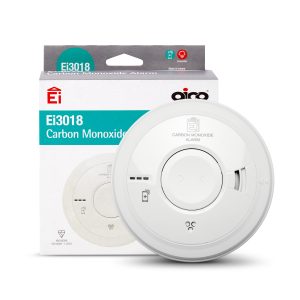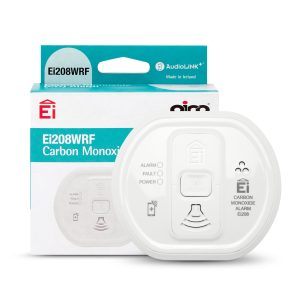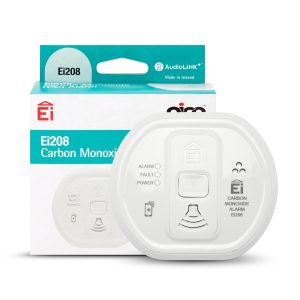Carbon Monoxide Alarms
Carbon Monoxide (CO) is an odourless, tasteless and colourless dangerous gas, which is produced by the incomplete burning of fossil fuels, such as gas, wood and coal. Carbon Monoxide is known as the ‘silent killer’ due to it being extremely difficult to detect.
The installation of Carbon Monoxide alarms measures and detects the level of Carbon Monoxide gas in the air. The British Standard BS EN 50292:2013 recommends Carbon Monoxide alarms be installed and maintained in every room with fuel-burning appliances and rooms where people sleep. Detect Carbon Monoxide and protect your premises from Carbon Monoxide poisoning with our innovative range of CO alarms.
Ei3018 Carbon Monoxide Alarm
3000 Series

Key features:
- Proven electrochemical sensor to monitor Carbon Monoxide levels
- Mains powered with 10-year rechargeable lithium cell back-up
Ei208WRF RadioLINK+ Battery Carbon Monoxide Alarm
200 Series

Key features:
- Powered by a sealed, 10-year life lithium battery
- Monitor background CO levels, alarm activations & sensor status with AudioLINK+ technology
Ei208 Battery CO Alarm
200 Series

Key features:
- Detects early signs of Carbon Monoxide
- Built-in AudioLINK+ data extraction technology
Carbon Monoxide Alarm FAQs
Your questions answered. Browse our FAQs to find the information you are looking for.
What is a carbon monoxide alarm?
A carbon monoxide alarm is a safety device that detects the presence of carbon monoxide gas. Browse our full range of carbon monoxide alarms to find the right model for your home or business.
Do carbon monoxide alarms detect smoke?
No, CO alarms do not detect smoke and will not alert you to a fire; they are designed to detect only carbon monoxide gas.
For full protection, you should install:
- CO alarms in any rooms containing a fuel-burning appliance or a flue, bedrooms and rooms in which occupants spend most of their time, as per the CO standard, BS EN 50292:2023.
- Smoke alarms as per recommendations within BS 5839-6:2019+A1:2020
Alternatively, you could install a combination detector that detects both carbon monoxide and smoke. Aico offers the Ei3030, which has both heat, smoke & carbon monoxide sensors to provide full coverage. You can find the full range of products here fire and carbon monoxide protection products.
Can a carbon monoxide alarm detect gas?
No, a carbon monoxide alarm can’t detect leaks such as natural gas (methane) or propane; these require different sensors. The role of a carbon monoxide alarm is to detect the presence of colourless, odourless carbon monoxide produced by incomplete combustion.
If you’re concerned about both CO and gas leaks, we recommend installing
- A CO alarm near bedrooms and fuel-burning appliances. For more information on where to position your alarms, view our alarm siting guide.
- A gas leak detector near stoves, furnaces or gas lines.
What does a carbon monoxide alarm sound like?
A carbon monoxide alarm emits a loud, high-pitched beeping or chirping sound in the following pattern: 4 quick beeps, a pause, then 4 quick beeps again (repeating the cycle), when dangerous levels of Carbon Monoxide are detected.
You may also hear other sounds such as:
- 1 beep every 60 seconds signals that your carbon monoxide alarm may have a low battery.
- 1 beep every 30 to 60 seconds and a flashing light, signalling your CO alarm is coming to the end of its life, and a replacement is required.
- Continuous chirping indicates a malfunction or sensor failure within the alarm.
If your alarm is beeping or showing a fault, visit our technical support or contact us for assistance.
How many carbon monoxide alarms do I need to install?
To remain compliant with carbon monoxide alarm legislations, a carbon monoxide alarm must be installed in any room containing a fuel-burning appliance in England and Wales, and in addition, Scotland and Northern Ireland require you to have a carbon monoxide alarm in any room containing a flue. For full legislative guidance, view our CO alarm legislation guide.
The carbon monoxide standard, BS EN 50292:2023, also recommends installing CO alarms in both bedrooms and frequently inhabited rooms, typically a living room, to ensure your safety in other areas of a property.
How to install a carbon monoxide alarm?
Installing a carbon monoxide alarm is straightforward. Follow these key steps:
Choose the right location: Carbon monoxide alarms should be installed in any room containing a fuel-burning appliance or flue, 1-3 metres horizontally from the appliance.
Installing the CO alarm
- For battery powered carbon monoxide alarms, e.g. Aico’s Ei208, screw the backplate into either the wall or ceiling dependant on the room you are installing in, and then twist the alarm head into position.
- For hardwired carbon monoxide alarms, have them installed by a qualified electrician.
After your carbon monoxide alarm is installed, be sure to test and maintain it going forward. See our alarm maintenance guide for full instructions.
How do carbon monoxide alarms work?
Carbon monoxide alarms work by monitoring the air for the presence of carbon monoxide gas. They use sensors, such as electrochemical sensors, to detect unsafe levels and trigger an alarm.
How long do carbon monoxide alarms last?
Carbon monoxide alarms typically last for 5 to 10 years. Check the manufacturer’s instructions for the specific lifespan of your alarm and replace it accordingly.
Aico carbon monoxide alarms have a lifespan of 10 years. After this period, the alarm may no longer detect carbon monoxide effectively, as the sensor and components can degrade over time.
Where do you put a carbon monoxide alarm?
Place carbon monoxide alarms on every level of the home, near sleeping areas, and in proximity to potential sources of carbon monoxide, such as gas appliances.
Can’t find what you’re looking for?
Email enquiries@aico.co.uk for more information
